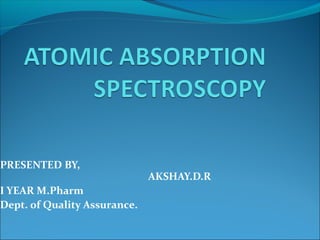
Atomic absorption spectroscopy
- 1. PRESENTED BY, AKSHAY.D.R I YEAR M.Pharm Dept. of Quality Assurance.
- 3. INTRODUCTION: Atomic Absorption Spectroscopy is a very common technique for detecting metals and metalloids in samples. It is very reliable and simple to use. It can analyze over 62 elements. It also measures the concentration of metals in the sample.
- 4. HISTORY: The first atomic absorption spectrometer was built by CSIRO scientist Alan Walsh in 1950. Shown in the picture Alan Walsh(left), with a spectrometer.
- 6. PRINCIPLE: The technique uses basically the principle that free atoms (gas) generated in an atomizer can absorb radiation at specific frequency. Atomic-absorption spectroscopy quantifies the absorption of ground state atoms in the gaseous state . The atoms absorb ultraviolet or visible light and make transitions to higher electronic energy levels. The analyte concentration is determined from the amount of absorption.
- 7. - Concentration measurements are usually determined from a working curve after calibrating the instrument with standards of known concentration. - Atomic absorption is a very common technique for detecting metals and metalloids in environmental samples. The wavelength of the radiation emitted is characteristic of the element & is used to identify the element ( Qualitative analysis). The intensity of the radiation emitted depends upon the concentration of the element analysed ( Quantitative analysis).
- 11. LIGHT SOURCE: Hollow Cathode Lamp are the most common radiation source in AAS. It contains a tungsten anode and a hollow cylindrical cathode made of the element to be determined. These are sealed in a glass tube filled with an inert gas (neon or argon ) . Each element has its own unique lamp which must be used for that analysis .
- 12. Quartz window Pyrex body Anode Cathode Hollow Cathode Lamp:Hollow Cathode Lamp: cathodecathode
- 13. NEBULIZER: suck up liquid samples at controlled rate. create a fine aerosol spray for introduction into flame. Mix the aerosol and fuel and oxidant thoroughly for introduction into flame.
- 14. Atomizer Elements to be analyzed needs to be in atomic sate. Atomization is separation of particles into individual molecules and breaking molecules into atoms. This is done by exposing the analyte to high temperatures in a flame or graphite furnace .
- 16. FLAME ATOMIZER: To create flame, we need to mix an oxidant gas and a fuel gas. in most of the cases air-acetylene flame or nitrous oxide- acetylene flame is used. liquid or dissolved samples are typically used with flame atomizer.
- 18. GRAPHITE TUBE ATOMIZER: uses a graphite coated furnace to vaporize the sample. ln GFAAS sample, samples are deposited in a small graphite coated tube which can then be heated to vaporize and atomize the analyte. The graphite tubes are heated using a high current power supply.
- 19. MONOCHROMATOR: This is a very important part in an AA spectrometer. It is used to separate out all of the thousands of lines. A monochromator is used to select the specific wavelength of light which is absorbed by the sample, and to exclude other wavelengths. The selection of the specific light allows the determination of the selected element in the presence of others.
- 20. DETECTOR: The light selected by the monochromator is directed onto a detector that is typically a photomultiplier tube , whose function is to convert the light signal into an electrical signal proportional to the light intensity. The processing of electrical signal is fulfilled by a signal amplifier . The signal could be displayed for readout , or further fed into a data station for printout by the requested format.
- 22. Calibration Curve A calibration curve is used to determine the unknown concentration of an element in a solution. The instrument is calibrated using several solutions of known concentrations. The absorbance of each known solution is measured and then a calibration curve of concentration vs absorbance is plotted. The sample solution is fed into the instrument, and the absorbance of the element in this solution is measured .The unknown concentration of the element is then calculated from the calibration curve
- 24. APPLICATIONS: Determination of even small amounts of metals (lead, mercury, calcium, magnesium, etc) as follows: Environmental studies: drinking water, ocean water. Estimation of Zinc in Insulin Injection. Estimation of elements in soil samples, H2O supplies, effluents, ceramics etc. Estimation of elements like Copper, Nickel, Zinc in food samples.
- 25. INTERFERENCES The sample solution contains other materials along with the element to be analyzed. The presence of this extraneous material in the sample solution results in Interferences. These Interferences causes inaccuracy in measuring the Intensity of desired radiation. Proper care should be taken to avoid interferences. So that good analytical results can be obtained.
- 26. Various Interferences are, • Spectral Interference- caused due to overlapping between 2 elements . Ex- Iron & Copper. Chemical Interference- Anionic ( Calcium Vs Phosphate to be stable). Cationic ( Sodium Vs Potassium). Interference due to Ionization . Ex- Sodium forms sodium ions . Background absorption Interference ( caused due to scattering of radiation ) Interference due to oxide formation.
- 27. REFERENCES: Vogel’s Textbook of Quantitative Analysis, G. Svehla, Pearson. Principles of Instrumental Analysis, VIDYASAGAR Basic Concepts Of Analytical chemistry, SIDDIQUE